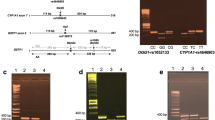Abstract
Background
Lung cancer is the leading cause of cancer death and is closely linked to tobacco smoking. Genetic polymorphisms in genes that encode enzymes involved in metabolizing tobacco carcinogens could affect an individual’s risk for lung cancer. While polymorphism of UDP-glucuronosyltransferase1A1 (UGT1A1) is involved in detoxification of benzo(a)pyrene-7,8-dihydrodiol(–), a major tobacco carcinogen, the association between UGT1A1 genotype and lung cancer has not been examined.
Methods
We retrieved the clinical data of 5,285 patients who underwent systemic chemotherapy at Kyoto University Hospital. A total of 765 patients (194 lung cancer patients and 671 patients with other malignancies) with UGT1A1 genotyping data were included in this analysis. We used logistic regression with recessive, dominant, and additive models to identify differences in genotype frequencies between lung cancer and other malignancies.
Results
In the recessive model, UGT1A1*28*28 genotype was significantly associated with lung cancer compared to other malignancies (odds ratio 5.3, P = 0.0083). Among lung cancer patients with a smoking history, squamous cell carcinoma was significantly predominant in patients with UGT1A1*28*28 compared to those with other UGT1A1 genotypes (P = 0.024).
Conclusion
This is the first study to demonstrate a significant association between the homozygous UGT1A1*28 genotype and lung cancer.

Similar content being viewed by others
References
Ferlay J, Soerjomataram II, Dikshit R et al (2014) Cancer incidence and mortality worldwide: sources, methods and major patterns in GLOBOCAN 2012. Int J Cancer 136:E359–E386. doi:10.1002/ijc.29210
Khuder SA (2001) Effect of cigarette smoking on major histological types of lung cancer: a meta-analysis. Lung Cancer 31:139–148
Gandini S, Botteri E, Iodice S et al (2008) Tobacco smoking and cancer: a meta-analysis. Int J Cancer 122:155–164. doi:10.1002/ijc.23033
Espina C, Straif K, Friis S, et al (2015) European Code against Cancer 4th edition: Environment, occupation and cancer. Cancer Epidemiol 20–33. doi:10.1016/j.canep.2015.03.017
Taioli E, Ford J, Trachman J et al (1998) Lung cancer risk and CYP1A1 genotype in African Americans. Carcinogenesis 19:813–817. doi:10.1093/carcin/19.5.813
Kawajiri K, Nakachi K, Imai K et al (1990) Identification of genetically high risk individuals to lung cancer by DNA polymorphisms of the cytochrome P450IA1 gene. FEBS Lett 263:131–133. doi:10.1016/0014-5793(90)80721-T
Pliarchopoulou K, Voutsinas G, Papaxoinis G et al (2012) Correlation of CYP1A1, GSTP1 and GSTM1 gene polymorphisms and lung cancer risk among smokers. Oncol Lett 3:1301–1306. doi:10.3892/ol.2012.665
Fang JL, Lazarus P (2004) Correlation between the UDP-glucuronosyltransferase (UGT1A1) TATAA box polymorphism and carcinogen detoxification phenotype: significantly decreased glucuronidating activity against benzo(a)pyrene-7,8-dihydrodiol(−) in liver microsomes from subjects with. Cancer Epidemiol Biomark Prev 13:102–109. doi:10.1158/1055-9965.EPI-03-0070
Hecht SS (2000) Tobacco smoke carcinogen and lung cancer. J Natl Cancer Inst 91:1194–1210
Onoue M, Terada T, Kobayashi M et al (2009) UGT1A1*6 polymorphism is most predictive of severe neutropenia induced by irinotecan in Japanese cancer patients. Int J Clin Oncol 14:136–142. doi:10.1007/s10147-008-0821-z
Sidak Z (1967) Rectangular confidence regions for the means of multivariate normal distributions. J Am Stat Assoc 62:626. doi:10.2307/2283989
Maruo Y, Nishizawa K, Sato H et al (2000) Prolonged unconjugated hyperbilirubinemia associated with breast milk and mutations of the bilirubin uridine diphosphate- glucuronosyltransferase gene. Pediatrics 106:E59. doi:10.1542/peds.106.5.e59
Kanai M, Kijima K, Shirahata E et al (2005) Neonatal hyperbilirubinemia and the bilirubin uridine diphosphate-glucuronosyltransferase gene: the common -3263T> G mutation of phenobarbital response enhancer module is not associated with the neonatal hyperbilirubinemia in Japanese. Pediatr Int 47:137–141. doi:10.1111/j.1442-200x.2005.02030.x
Kobayashi M (2012) Is there diversity among UGT1A1 polymorphism in Japan. World J Gastrointest Oncol 4:170. doi:10.4251/wjgo.v4.i7.170
Bosma PJ, Chowdhury JR, Bakker C et al (1995) The genetic basis of the reduced expression of bilirubin UDP-glucuronosyltransferase 1 in Gilbert’s syndrome. N Engl J Med 333:1171–1175. doi:10.1056/NEJM199511023331802
Beutler E, Gelbart T, Demina A (1998) Racial variability in the UDP-glucuronosyltransferase 1 (UGT1A1) promoter: a balanced polymorphism for regulation of bilirubin metabolism? Proc Natl Acad Sci USA 95:8170–8174
Tukey RH (2002) Pharmacogenomics of human UDP-glucuronosyltransferases and irinotecan toxicity. Mol Pharmacol 62:446–450. doi:10.1124/mol.62.3.446
Yamamoto K, Sato H, Fujiyama Y et al (1998) Contribution of two missense mutations (G71R and Y486D) of the bilirubin UDP glycosyltransferase (UGT1A1) gene to phenotypes of Gilbert’s syndrome and Crigler-Najjar syndrome type II. Biochim Biophys Acta Mol Basis Dis 1406:267–273. doi:10.1016/S0925-4439(98)00013-1
Thorgeirsson TE, Geller F, Sulem P et al (2008) A variant associated with nicotine dependence, lung cancer and peripheral arterial disease. Nature 452:638–642. doi:10.1038/nature06846
Yang IA, Holloway JW, Fong KM (2013) Genetic susceptibility to lung cancer and co-morbidities. J Thorac Dis 5(Suppl 5):S454–S462. doi:10.3978/j.issn.2072-1439.2013.08.06
Acknowledgements
The authors express their gratitude to Dr. Masahide Onoue, Mr. Yasuaki Ikemi, Mr. Naoya Ishibashi and all the staff in the Department of Pharmacy, Kyoto University Hospital for UGT1A1 genotyping. This research was partially supported by a grant from the Practical Research for Innovative Cancer Control from the Japan Agency for Medical Research and Development.
Author information
Authors and Affiliations
Corresponding author
Ethics declarations
Conflict of interest
Dr. Narahara received research funding from Toyobo Biotechnology Foundation. Dr. Muto received research funding from Taiho Pharmaceutical and Mitsui Knowledge Industry. No other potential conflict of interest relevant to this article was reported.
About this article
Cite this article
Nishikawa, Y., Kanai, M., Narahara, M. et al. Association between UGT1A1*28*28 genotype and lung cancer in the Japanese population. Int J Clin Oncol 22, 269–273 (2017). https://doi.org/10.1007/s10147-016-1061-2
Received:
Accepted:
Published:
Issue Date:
DOI: https://doi.org/10.1007/s10147-016-1061-2




